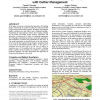Free Online Productivity Tools
i2Speak
i2Symbol
i2OCR
iTex2Img
iWeb2Print
iWeb2Shot
i2Type
iPdf2Split
iPdf2Merge
i2Bopomofo
i2Arabic
i2Style
i2Image
i2PDF
iLatex2Rtf
Sci2ools
GIS
2007
ACM
2007
ACM
Cell-based generalization of 3D building groups with outlier management
In this paper, we present a technique that generalizes 3D building groups of virtual 3D city models according to a cell structure that is derived from infrastructure networks. In addition, the technique handles vegetation areas and outliers such as landmark buildings. zed 3D representations abstract from complex, detailed 3D city models and enable storage, analysis, exploration, and interaction at varying levels of scales. Our technique implements the cartographic generalization operators clustering, aggregation, and accentuation; it performs the generalization in four steps: 1) City model components are clustered based on the cell structure. 2) For each cell, the weighted average height is calculated, which is also used to automatically identify outliers. 3) Free space is subtracted from the cells such as in the case of outliers or vegetation areas. 4) The modified cells are extruded to building blocks; vegetation areas and outliers are modeled or, respectively, integrated separately...
| Added | 07 Jun 2010 |
| Updated | 07 Jun 2010 |
| Type | Conference |
| Year | 2007 |
| Where | GIS |
| Authors | Tassilo Glander, Jürgen Döllner |
Comments (0)

